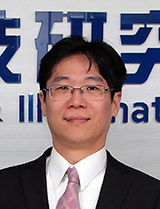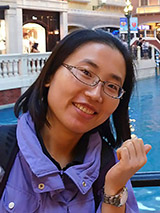- 2024
- Spectral Imaging Experts' Day
- Upcoming ICC Meetings
- 2023
- London Meeting Invited Speaker session
- 2022
- HDR Experts' Day
- 2020
- ICC DevCon 2020
- Munich, 10-11 February
- 2019
- ICC Color Experts' Day, Bressanone
- 2018
- ICC Color Symposium Hong Kong, 22 October
- Grand Rapids, MI, 30-31 May
- ICC DevCon 2018
- Munich, 25-26 February
- 2017
- Ryerson Toronto Graphic Arts Day, 13 October
- Toronto, 11-12 October
- Prague Graphic Arts Experts' Day, 29 June
- Prague, 27-28 June
- Tokyo, 19-20 April
2016 ICC DevCon Program

| 8:30am | Conference Intro Note |
|
ICC Chair - William Li
|
|
| 8:45am | Introduction to iccMAX from the Business Perspective |
 |
William Li Kodak
The International Color Consortium (ICC) was established for the purpose of creating, promoting and encouraging the standardization of an open, vendor-neutral, cross-platform color management system architecture and components. The outcome was the development of the ICC profile specification. The ICC has completed the new specification, iccMAX that enables new ways of openly communicating about light, color and appearance. The result of this effort is that several real world scenarios can now be directly addressed using iccMAX based approaches that could not be easily addressed with previous open color management solutions. iccMAX represents a next-generation color management system that expands upon the existing ICC.1 profile format and architecture. After identifying some of the limitations of ICC.1, an introduction and overview of the concepts in the iccMAX specification will be presented. Examples of new features introduced in iccMAX include spectral processing, material identification and visualization, BRDF, new data types, an improved gamut boundary descriptor, and support for arbitrary and programmable transforms. The intent of this presentation is to provide an introduction to iccMAX with specific details and applications left to other presenters during the conference.
Bio:
|
| 9:15am | Color tuning of a painting by a multispectral lighting system - an iccMAX-based approach |

|
Pei-Li Sun, Wei-Chun Hung NTUST, Taiwan
There are several known causes of discoloration problems on painting, such as exposure to light, dust, and air. The faded colors are possible to be recovered to some degree by using a multispectral lighting system. As more and more cost effective commercial tunable multispectral LED systems are available in the professional lighting market, how to determine input signals of the LED lamps is the key question which affects the result of color appearance greatly. iccMAX is a powerful tool which can be used to characterized a multispectral camera as well as a multispectral LED system. The spectral reflectance of principal colors on a painting can be estimated by the spectral camera. The best combination of the LED signals can be determined by minimizing a cost function with the criteria of color tuning. The talk will introduce experiments, modeling and results for the iccMAX-based multispectral lighting application.
Bio:
Pei-Li Sun received his Ph.D. at the Colour & Imaging Institute of the University of Derby in England in 2002. He is an assistant professor at Graduate Institute of Color and Illumination Technology in National Taiwan University of Science and Technology. His current research interests are image quality enhancement, appearance measurement, and color vision. . |
| 9:45am | A Spectral Workflow for Encoding and Analyzing Artwork with iccMAX |

|
Ben Bodner and Roy Berns RIT
A high-resolution spectral imaging workflow for digital archival of artwork is presented. This system allows for accurate rendering of paintings and other artwork under any viewing conditions. Implementations of several new features provided by iccMAX are illustrated in the context of the system?s imaging chain, including spectral PCS, material connection space, the programmable stack calculator, and BRDF data encoding. Several MatLab GUI tools that assist in the development of iccMAX profiles are also presented.
Bio:
Dr. Roy S. Berns is the Richard S. Hunter Professor in Color Science, Appearance, and Technology within the Program of Color Science at Rochester Institute of Technology, USA where he developed both M.S. and Ph.D. degree programs in Color Science. He directs the Andrew W. Mellon Studio for Scientific Imaging and Archiving of Cultural Heritage. He received B.S. and M.S. degrees in Textiles from the University of California at Davis and a Ph.D. degree in Chemistry from Rensselaer Polytechnic Institute. He has received lifetime achievement awards from the International Association of Colour, the Colour Group of Great Britain, and the Inter-Society Color Council. |
| 10:15am | Coffee Break |
| 10:30am | Modeling Colour Vision Deficiency with ICC Profiles |
 |
Phil Green NTNU in Gjøvik
Colour vision deficiency (CVD) affects a significant number of individuals. A number of papers have focused on either simulating the appearance of a colour image to a CVD observer, or adjusting the image to improve the discriminability of colours to such observers. In this paper we show how ICC profiles can be used to handle a wide variety of published transforms in this field. While some transforms can readily be encoded in v4 LUT-based profile, the new iccMAX architecture provides some additional possibilities, such as parameterized transforms for individual observers, encoding of functional transforms in the MPE and Calc elements, and the use of custom colorimetric observer and profile connection space. By using the ability to connect spectral data, iccMAX profiles also enable computation of the spectral response of the CVD observer to a given spectral reflectance, light source or emission.
Bio:
|
| 11:00am | Correction of Display Viewing Angle with ICCMax |
 |
James Vogh X-Rite
The color and intensity of the light from a LCD display panel typically varies with the angle that the display is viewed from. ICC version 4 display profiles characterize a display from only one viewing angle (typically perpendicular to the surface). The characterization of the display by the profile can therefor have poor accuracy unless the display is view from the same angle as the profile was made. Additionally, if the display is viewed from a close distance, the viewing angle can have a significant variation across the screen. Various head and eye tracking technologies can track an observer's location while a display is being observed so that an observer's viewing angle can be computed. ICCMax includes a set of profile tags that allow a display to be characterized for both viewing angular and spatial location. This presentation will demonstrate a method of measuring a display from different viewing angles, building an ICCMax profile for the display with the measurement data, and applying the profile with a GPU. Measurement is made with a colorimeter mounted on a tripod and aimed at the center of the display screen. iccMax supports a new set of tag formats that are similar to the A2B & B2A tags but also support angular and spatial input parameters. The angular inputs are the azimuth and zenith of the viewing vector and the spatial parameters are the spatial coordinates on the screen. The new tags are implemented as a multi-processing element type and can contain calculator elements. The profile to be demonstrated is an implemented as a matrixTRC profile with multiple viewing angles. The calculator element is used to select the correct set of curves and matrices to use, apply the curves and matrices, and interpolate the results for the current viewing angle. The application of the profile is demonstrated as openGL shader code that implements the elements of the multi-processing element.
Bio:
|
| 11:30am | Implementing Observer Metamerism Correction on Wide Color Gamut Display using iccMAX Framework |
 |
Chris Bai BenQ
New technologies have been developed to widen the color gamut on displays, and wide color gamut display in theory can improve the accuracy in soft proofing application, and exhibit a better reproduction of the real world colors. Quantum Dot technology is one of the technologies which enable displays to achieve full coverage of Adobe RGB, DCI-P3 and the latest Rec. 2020 color gamut. The technology involves using UV and the blue portion of the light spectrum to excite the chemicals to produce narrow band green and red lights. However, recent studies have shown that displays with narrow band spectrum will result in a lesser perfect reproduction than CCFL displays can achieve. The reason was believed to be the variation in each observer?s color matching function. A small variation will result in a huge difference in XYZ values due to concentrated energy in particular bandwidths. In this study, observer?s color matching function was categorized and the spectral characteristic of the display was measured. The individual observer color matching function along with the spectral data of the wide color gamut display were encoded with the latest iccMAX framework to deliver an improved performance comparing with no observer metamerisim correction in color matching experiment.
Bio:
|
| 12:00pm | Lunch Break with table presentations |
| 1:00pm | WORKSHOP Hands-on with RefIccMAX |
 |
Max Derhak Onyx Graphics
In this session a hands-on workshop will be conducted utilizing the reference implementation library and tools for iccMAX. RefIccMAX represents a jumping board by which one can begin to create and use iccMAX profiles. Topics that will be covered include:
Some familiarity with ICC color management is recommended. Though some software programming topics will be covered, extensive knowledge of programming is not required to benefit from this workshop.
Bio:
|
| 5:00pm | Evening Reception and Booth Presentation (ends at 7pm) |
Back to the main DevCon page



